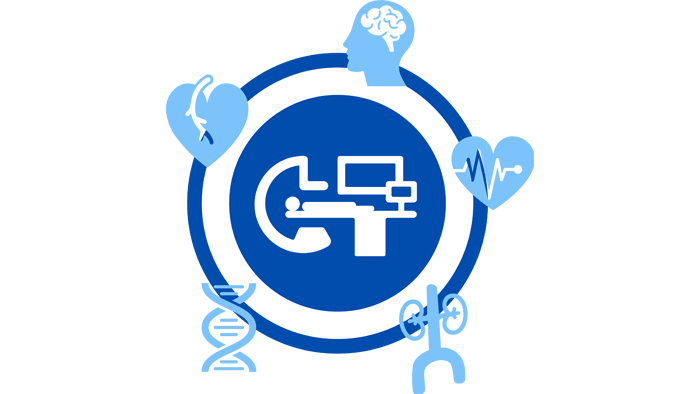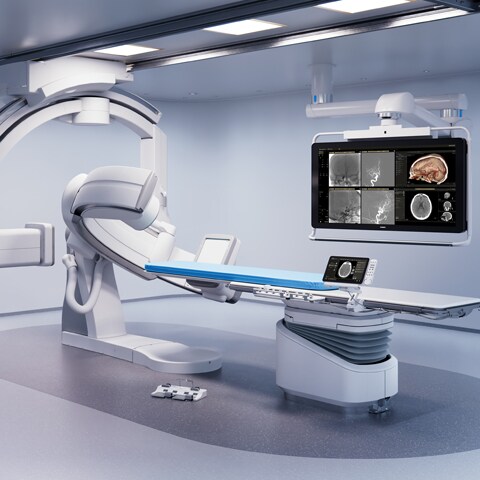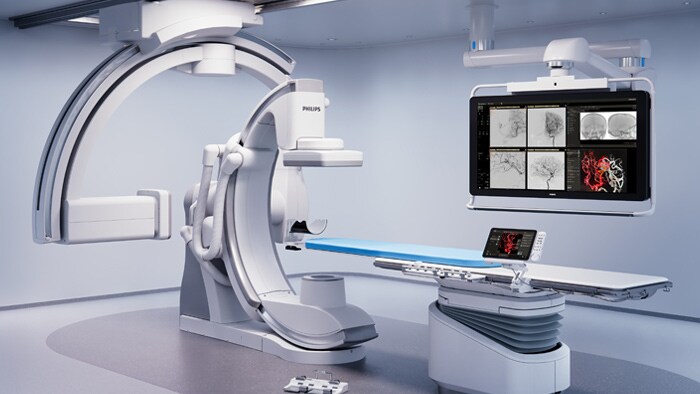Explore our most flexible system ever
Innovatively designed to support even the most challenging procedures
Perform a wide range of routine and complex interventional procedures easily and confidently with the advanced system connectivity and innovative geometry of the Image Guided Therapy System – Azurion. The Azurion biplane system for neuro interventions offers enhanced rotation, angulation and parking functionality, with SmartCT for 3D applications to speed up confident decision-making. Use our remote secure network to discover system issues before they become problems, helping achieve the high lab uptime that lets you treat more patients. With Azurion, you are future-ready.
Work smarter, not harder
say they’re more efficient. These users believe that Azurion can help them make more efficient use of their time spent in the lab.1
The Philips Azurion series design and development is committed to meeting sustainability and circular economy ambitions by reducing the product’s environmental impact.2
Before you’re even aware that there’s an issue, we’re working to fix it, through secure remote services that deliver proactive model-based analytics to identify issues in the background.3
Meet the new Azurion, our most flexible biplane system ever
Meet the new Azurion,
our most flexible biplane system ever
Innovatively designed to support the most challenging procedures
The Azurion Image Guided Therapy Biplane System is designed to empower your workflow through advanced ergonomics and imaging capabilities. Advanced capabilities, such as SmartCT for 3D imaging, are integrated with innovative system geometry to support improved workflow, helping you to optimize your lab performance and provide superior care to your patients. With the industry-leading Azurion, we reinforce our commitment to you and your patients. Azurion is designed to help you meet your challenges, today and tomorrow.
Featured innovations
- 1/3
SmartCT Soft Tissue Helical for improved image appearance
Improves neuro CBCT images to identify soft tissue changes in the Angio suite. An advanced protocol with dual-axis acquisition trajectory and improved reconstruction software results in improved image appearance, compared to conventional CBCT acquisition techniques.
- 2/3
Identify vessel occlusions and collaterals to enhance treatment decisions with SmartCT Dual Phase Cerebral
SmartCT Dual Phase Cerebral allows for the acquisition of two consecutive contrast-enhanced CBCT (angio) scans of the brain to identify vessel occlusions and collaterals, with bolus watch to monitor contrast arrival to the brain to start the early phase acquisition scan.
- 3/3
Fuse 3D datasets for guidance during the procedure with SmartCT Dual Viewer
SmartCT Dual Viewer offers 3D fusion imaging of 3D-RA and CBCT datasets during the procedure to support assessment and diagnosis. Load any two volumes from Azurion and compare at tableside without breaking sterility or switching applications.

Experience a system designed around you
Azurion Image Guided Therapy Biplane System for neuro is an iF Gold Award 2025 winner. In announcing the award, iF stated: “This is human-centered design at its best. The holistic user experience across different touchpoints is clearly the result of long and careful consideration.

With the Azurion system, we were able to change our workflow in such a way that we now can do more patients in a single day, resulting in more patients a week, resulting in more patients per year, with no compromise to patient safety or quality of care.”
Marco van Strijen, MD, Interventional Radiologist
St. Antonius Hospital, Utrecht/Nieuwegein, the Netherlands
The Philips neuro biplane system allows us to provide superior patient care and make critical decisions faster, ultimately improving recovery times for our cerebrovascular patients.
Dr. Robert Wicks, Co-Director of Cerebrovascular Surgery, Director of the Neurosurgical Anatomy Laboratory
Baptist Health Miami Neuroscience Institute, Miami, FL, USA
Switching between 3D acquisition and 2D imaging is faster with the new system.Dr. Maxim Bester, Senior Physician Vascular & Interventional Neuroradiology
Universitätsklinikum Hamburg-Eppendorf (UKE), Hamburg, Germany

One system, multiple workflows
Advanced capabilities integrated with innovative system geometry support improved workflow, helping you to optimize your lab performance and provide superior care to your patients.
Disclaimer:
SmartCT R3.0 is subject to regulatory clearance and may not be available in all markets. Contact your sales representative for more details.
Footnotes
1 Evaluated with clinical users in a simulated lab environment.
2 Determined via the COCIR SRI method. Compared to the predecessor Allura Xper platform. Exact energy reduction depends on configuration.
3 Based on First-Time-Rate data from 2021 for Allura and Azurion systems that were remotely connected (n=12.205) for corrective maintenance.










